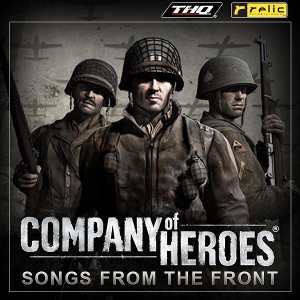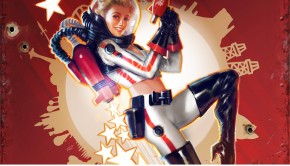Company of Heroes Original Soundtrack
 |
Album Title: Company of Heroes -All Heroes Rise- Company of Heroes -Songs from the Front- |
| Record Label: Valve |
|
| Catalog No.: N/A |
|
| Release Date: January 21, 2010 |
|
| Purchase: Download at Steam |
Overview
Relic Entertainment and THQ’s Company of Heroes proved a hit among military video game fans with its World War II setting and real-time strategy gameplay. The music for this game and its stand-alone expansion Company of Heroes: Opposing Fronts were eventually packaged together in two digital soundtracks freely released through Steam. The games were scored by an impressive trio, consisting of Jeremy Soule, Ian Livingstone, and Inon Zur, with Soule working on the original game and the other two scoring the expansion. Being a huge fan of Soule’s trademark epic, sweeping, cinematic scores, I was particularly curious to see what he had contributed to this score; Company of Heroes seems to be an unusually realistic game for Soule, who is most well-known for his scores to fantasy RPGs like The Elder Scrolls, Guild Wars, and Icewind Dale. I ended up was a little disappointed after hearing the final results.
Body
While most of the music for Company of Heroes and its expansion works in the game, it rarely makes great stand-alone listening. Almost all of the tracks are tense, mood-setting pieces meant to evoke an unsettling feeling instead of creating a continuous score. A few of the tracks have hints of themes running through them, but because most are about a minute in length, they are too short for any serious development, in contrast to Cris Velasco’s work for the sequel.
The album Company of Heroes: All Heroes Rise is the most action-packed of the two, but also the least inspiring. It begins with “Twilight on Approach”, written by Inon Zur. The track begins with soft, dissonant strings rising in pitch until they are met with an eerie choir. Finally, the piece ends with some low brass beating out a military march. All of this takes place in one minute and seventeen seconds, and seamlessly flows into the second track, “Surveying the Enemy”, by Jeremy Soule. This one phases out the brass in favor of snare drums, keeping the rhythm steady for one minute and five seconds. The pieces continue like this — short, choppy, mood-inducing pieces without any significant development.
Inon Zur scores very similarly to Soule on these tracks (no stranger to succeeding Soule, having scored the sequel for Icewind Dale). Most of the pieces that are written by Soule or Zur sound very similar; the constant percussion and dissonance combined with the short length on the tracks make the listener struggle to hear where one track ends and the other begins. Zur’s “We Came in the Night” occasionally hints at a larger musical theme, but the piece ends with jarring, erratic string movements before any theme is fully realized. Soule’s “Lit by the Fires of Battle” gives the percussion a break, but remains relatively monotonous as the piece consists of a constantly held-out high strings broken by the occasional ripple of low brass.
Ian Livingstone is the highlight of this soundtrack. “The Wake of Battle” features strings offset by a gentle flute playing what might be the first genuine melody in the score (at track 12). It’s not much, and the 1:02 piece is over before anything can come of it, but it is followed by Livingstone’s “Silent Call to Action”, which features a lower string ostinato that is rather catchy as it continues, later accented with some xylophone and pizzicato. “The Month of Valiant Effort” contains a rather fun flurry of strings and brass, almost reminiscent of a battle theme from Final Fantasy games.
Company of Heroes: Songs from the Front is a more developed, thematic soundtrack of the two digital albums. Opening with “Sunrise on the Battlefield”, it features a beautiful horn solo, laced with a single oboe and followed by some strings echoing the same melody. Ian Livingstone follows up this ‘Soulian’ entrance with “Tales of the Front” and “The End of B Company”, both of which contain Livingstone’s ability to incorporate more melodic elements into his work. “All Plans in Motion” similarly combines rapidly moving strings with a single, mournful vocal line, while “A Company of Heroes” utilizes the entire orchestra to create a triumphant, almost soulful, theme; in contrast, it’s followed by To Those Who Rest, which begins with intertwined flute and strings, and closes with a soft oboe and clarinet combination.
Inon Zur’s pieces on this album seem to have improved from All Heroes Rise. While he makes less of a contribution, the pieces he does include have more of a form to them. “Courage to Stand”, for example, keeps with the constant rhythms and incorporates a four-note motif in the background, but includes a melody on French horn and trumpet that stretches over the entire piece. “In the Eye of a Sniper” actually brings that four-note motif back in a different setting, giving a semblance of continuity to the disc as a whole.
Many of the other pieces, like Invasion by Moonlight or They’re Out There Somewhere, follow the pattern of All Heroes Rise, with little to no thematic elements or development, favoring long chords, heavy, often sporadic, percussion, and dissonance. Soule closes this soundtrack with the imaginatively-named “Untitled”, which follows much like the opening — bright, complex, and emotional. It opens with a string pattern that ultimately develops into a countermelody, played under a horn that enters shortly and introduces a beautiful theme that ebbs and flows as the piece continues, undergoing both development and variations until it finally reaches its strongest point with the entrance of a choral setting of the melody.
Summary
I wish more of the soundtrack had followed in the style of “Untitled”. These composers clearly all have a strong talent, but it simply didn’t come through as much as it could have in this soundtrack. It’s also clear that the artists never worked altogether collaboratively; while pieces by a single composer sound like they could fit together as part of a larger soundtrack, any two pieces by two different composers seem as though they were written very different times and places. Even though there are similar elements of each piece, there is very little substantial material to really tie them all together into a single, cohesive soundtrack; instead, the effect is a collection of tracks that evoke a mood, but not an entire game. These releases are available for free, so might still be worth checking out if you’re a fan of the in-game music or militaristic orchestrations. However, I’d recommend the sequel soundtrack for a much better all-round listening experience.
Do you agree with the review and score? Let us know in the comments below!
3
Posted on June 28, 2014 by Emily McMillan. Last modified on June 28, 2014.













